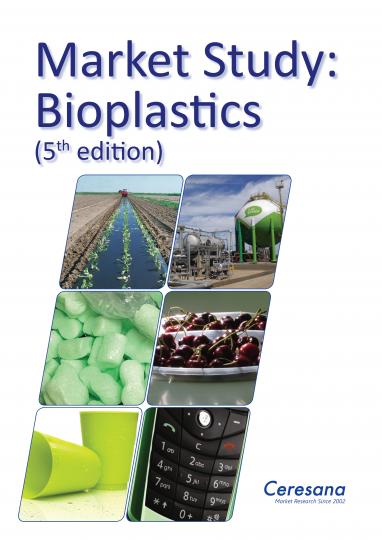Flexible & Pouches
Green boom: Ceresana forecasts further growth for bioplastics
Published
4 years agoon
By
BXP Reader
Polylactic acids, starch blends, cellulose, and other bioplastics achieve significantly higher growth rates than conventional standard plastics made of mineral oils or natural gases. „Bioplastics can be used in a growing number of application areas,“ explains Oliver Kutsch, CEO of market research institute Ceresana. With its newest study, Ceresana has examined the world market for “green” polymers for the fifth time already. Analysts predict their future development to remain dynamic: revenues generated with bioplastics are expected to reach approx. USD 4.4 billion by 2026.
“Bio” is not always compostable
Two groups of materials are called bioplastics, although they are not necessarily identical: biodegradable plastics can be composted, whereas bio-based plastics are made of renewable resources but are not always biodegradable. Biodegradable plastics, such as polylactic acids (PLA) and polymers on the basis of cornstarch, reached a market share of 56% of the total market for bioplastics in 2018. Ceresana predicts volume growth of 7.1% per year up until 2026 for this product group. Growth regarding bio-based plastics such as polyethylene, PET, or PA made of sugar cane, which are not biodegradable, is expected to be weaker, with 5.1% per year.
Packaging is the main application
This study by Ceresana analyzes the development of bioplastic usage in various sales markets in detail. Demand is subdivided into the categories rigid and flexible packaging, consumer goods, automotive and electronics, and other applications. The most important sector for sales of bioplastics in 2018 was the packaging industry – more than 60% of bioplastics were processed to bags, sacks, and other types of packaging. However, Ceresana expects the highest percentage increase in the future for the category automotive and electronics with 8.4% per year.
Manufacturers and processors of bioplastics are facing great challenges: prices, availability, and quality need to be able to compete with fossil resources. Alternatively, they must offer added value in order to justify the price difference to consumers. Recycling and composting are an advantage for many applications. However, the existing infrastructure of disposal companies plays a decisive role in this respect: problems arise when plants are not designed to separate bioplastics or when they are unable to biodegrade them. Temperatures that are needed for quick composting of bioplastic bags are, for example, nor always reached.
AdvertisementThe study in brief:
Chapter 1 provides a comprehensive analysis of the global market for bioplastics – including forecasts until 2026: the development of demand, revenues, and production is presented for each region. Furthermore, individual application areas for bioplastics are examined. We differentiate between the categories rigid packaging, flexible packaging (bags and sacks), other flexible packaging, consumer goods, automotive and electronics, and other applications. Chapter 2 examines the eight most important countries for sales of bioplastics separately: Germany, France, the United Kingdom, Italy, Spain, USA, China, and Japan. Demand and revenues, demand within individual application areas, demand per product type (PLA, starch-based, other biodegradable plastics, non-biodegradable plastics made of renewable resources) are presented. Chapter 3 provides useful company profiles of the most important manufacturers of bioplastics, clearly arranged according to contact information, revenues, profits, product range, production sites, and profile summary. In-depth profiles of 75 manufacturers are listed. Further information: www.ceresana.com/en/market-studies/plastics/bioplastics/
About Ceresana
As one of the world’s leading market research companies, Ceresana is specialized in the plastics, chemicals, packaging, and industrial goods sectors. Since 2002, companies have benefited from high-quality industry analyses and forecasts. More than 180 market reports provide over 10,000 customers with the knowledge base for their sustainable success. Learn more about Ceresana at www.ceresana.com/en
Advertisement
Editorial Note: This post was shared by a member of the BXP magazine community using our Community Voice tool.
Our website community uses the tool to post articles, thought-leadership reports and analyses, white papers, case studies, blog entries and op-eds, press releases and events about brand and package design or marketing. These posts are vetted and edited by our editorial staff for editorial relevance and decorum for branding, design, marketing and package design professionals. Approved and edited content then lives side-by-side with other editorial content. Overtly promotional content is not accepted, but we do have advertising options available for those interested in promoting their services or products.
Do you want to become a contributing author to the BXP website? Click here to learn how you can become a contributing member of the BXP Magazine community.
SPONSORED VIDEO
Branding with Ferocity – Thinking Like an Indie Brand
Get a better understanding on how to leverage new technologies to engage and delight shoppers, sustainability’s role in product and package design – being sustainable and premium are not mutually exclusive, plus best practices and tips for collaboration and how to launch new products and refresh existing product line-ups and brands.
You may like
Advertisement
Subscribe

BULLETINS
Get the most important news and business
ideas from BXP Magazine's news bulletin.
Advertisement







